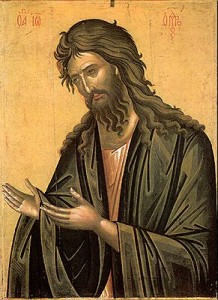 Saint John’s preaching dealt with the problem of sin, and with what was required for sinners to be reconciled to God. The recurring theme of his preaching was repentance. He announced repentance as the only way to be prepared for the coming of God’s kingdom.
Saint John’s preaching dealt with the problem of sin, and with what was required for sinners to be reconciled to God. The recurring theme of his preaching was repentance. He announced repentance as the only way to be prepared for the coming of God’s kingdom.
Matthew 3:1-3 “In those days came John the Baptist, preaching in the wilderness of Judea. And saying, Repent ye: for the kingdom of Heaven is at hand. For this is he that was spoken of by the prophet Esaias, saying, The voice of one crying in the wilderness, Prepare ye the way of the Lord, make his paths straight.”
It is not possible to think about the beginning of Jesus’ public ministry without seeing St. John the Baptist somewhere in the picture. The Gospel of St. Mark, believed to be the earliest of the four Gospels, begins by referring to St. John, indicating that he was baptizing “in the wilderness” (Mark 1:4). The other three gospels follow St. Mark in prefacing the ministry of Jesus with that of St John the Baptist.
Saint John was about six months older than Jesus, and their mothers were relatives (Luke 124-27, 36). Thus St. John, like Jesus, was a young man of about 30 years of age when he began his public ministry.
St. John’s sermons centered around a common theme: “Repent ye: for the kingdom of heaven is at hand” (Matthew 3:2). Apparently St. John’s manner of delivery was authoritative and fiery, for he seized the attention of all who heard him. The voice of a Spirit-inspired and filled prophet had not been heard in Palestine since the preaching of Malachi the prophet four centuries before.
“Repentence” involves a radical change of mind and behavior. The person who repents looks at his past with honest and genuine remorse. Then he turns from that life of self-centered disobedience and turns to God.
St. Matthew the evangelist introduced St. John as the messenger who would herald the coming of the Messiah, as prophesied by Isiah the prophet (Matthew 3:3; Isiah 40:3).
Matthew 3:4-6 “And the same John had his garment of camel’s hair, and a leathern girdle about his loins; and his meat was locusts and wild honey. Then went out to him Jerusalem, and all Judea, and all the region round about Jordan. And were baptized of him in Jordan, confessing their sins.”
St John’s appearance was striking. His clothing was extremely rustic-a camel’s hair suit! He wore a leather belt, and probably crudely fashioned sandals. His appearance was not designed to appeal to the educated, the cultured, or city dwellers. His food was equally plain, certainly not a gourmet’s diet. He fared on “locusts and wild honey”. Most Bible expositors believe the locusts referred to is a member of the grasshopper family. No doubt St. John’s humble diet was nutritionally adequate, with a good balance of protein and vitamins.
St. John’s austere food and clothing were further evidences of his total commitment to his mission. These material things were mere necessities, and the simplest way he could take care of them pleased the Saint. No doubt his rustic clothing reminded the people of the ancient prophets.
The people were drawn to St. John; they came out to hear him not only from Jerusalem but also from the entire region of Judea. And many “were baptized of him in Jordan, confessing their sins” (vs. 6). The authority of St. John’s preaching, given its thrust by the power of the Holy Spirit upon him, brought conviction to the hearts of the people. As a result of his plain preaching, they saw themselves as sinners in need of repentance and divine forgiveness. They submitted to St. John’s baptism not just to identify themselves with this prophet, but also to demonstrate their sincerity in confessing their sins.
